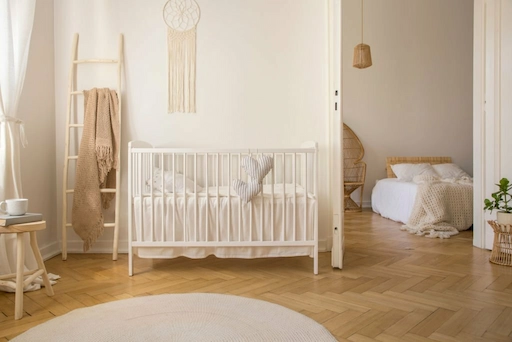Why Should Crib Be Away From the Wall?

Ensuring a safe sleep environment for babies is extremely important. According to safety guidelines from organizations like the American Academy of Pediatrics (AAP), one key recommendation is to place a baby’s crib away from the walls of the room. But why exactly should the crib not be pushed up against a wall?
Safest Place to Put a Crib

When it comes to deciding the safest place to put a crib in the nursery, there are several key factors to consider. It’s important to keep the crib at least a foot away from the wall to prevent any hazards, such as getting caught in blind cords or drapes.
Avoid placing the crib near a window, as this can pose a risk to your baby or toddler, particularly in regards to strangulation from window blind cords. Placing your baby’s crib in the middle of the room can be the safest option, away from any potential hazards.
Additionally, it’s also crucial to keep the crib away from any changing tables or other furniture that could be used to climb out of the crib. Ultimately, the safest place to put a crib is in a room with the crib near the middle, away from windows and blind cords, and with the crib mattress lowered to its lowest position.
Reducing Baby’s Exposure to Toxins and Allergens
One main reason experts suggest keeping the crib away from walls is related to potential toxins and allergens that could accumulate on wall surfaces. For example, elements like dust, dander, mold spores, and gases like radon could gather in higher concentrations near walls over time.
By positioning the crib away from the wall, there is increased airflow and ventilation around the baby’s sleep area. This helps disperse and dilute any hazardous substances that may be lingering on walls or in the adjacent surroundings, thereby lowering the baby’s exposure:
Allergens and Irritants
Babies may be more prone to experiencing allergic reactions or respiratory irritation when inhaling allergens like dust mites, pet dander, or mold that gathers in spaces bordering walls. Keeping a buffer zone around the crib provides cleaner, fresher air for breathing.
Gases and Pollutants
Gases like radon or volatile organic compounds (VOCs) from household products, paints, or finishes have a higher chance of accumulating along walls. Distancing the crib allows better dispersion before the baby inhales nearby air.
Facilitating Caregiving and Supervision
Another reason cribs in the middle of the room are favored relates to easier caregiver access and better baby monitoring.
Accessibility for Caregiving Tasks
Having the crib positioned away from any walls provides open, unrestricted access on all sides for parents or caregivers. This makes it much simpler to reach in to easily lift baby in and out for things like feeding, soothing, changing diapers, or putting baby down to sleep.
With a wall bordering one side, the caregiver’s movements and ability to safely perform caregiving duties can feel more confined or awkward.
Clear Lines of Sight
An additional advantage to an open crib arrangement has to do with oversight while the baby is sleeping. With a view unobstructed by tight wall constraints, parents can more clearly check on the baby from all angles and ensure he or she is safe and comfortable.
For example, potential hazards like blanket bunching around a baby’s face or limbs escaping out between bars are easier to identify early when sightlines are maximized by keeping the crib in an open floor plan. Cribs in corners or flat against walls leave whole zones out of view for proper supervision.
Preventing Hazards Related to Wall Proximity
Placing cribs near walls also increases associated risks of certain safety hazards occurring in and around the baby’s sleep space. Keeping a safe distance minimizes chances of suffocation, limb entrapment, or injury if the baby rolls against stable surfaces.
Suffocation Risks
Bedding, blankets, or soft items accidentally pressed against walls and faces pose suffocation dangers. Parents may also unintentionally allow cribs to shift too close if abutting moveable room dividers or freestanding crib bumpers. Leaving ample room for airflow on all sides helps avoid these threats.
Limb Entrapment Issues
Babies actively rolling or scooting run the risk of getting arms, legs or even heads accidentally wedged between crib bars and walls—especially with older, poorly-designed cribs. Separating the crib prevents limbs from potentially getting pinched, trapped, or fractured if forcefully hitting immobile surfaces.
Buffer From Tumbling Impact
Finally, further distance safeguards the front zones of the crib should babies ever climb up rails and tumble overboard during sleep cycles. Having space cushions potentially impacts against ground or wall structures if babies lose balance and fall while pulling up or peering over the edge. Setbacks give a little safety buffer.
Transitioning Crib Away From Wall Over Time
When first transitioning a baby into a crib, it’s understandable some parents may favor spots snug against walls to feel more secure about placement. However, by being mindful of safety guidelines, caregivers can gradually shift the crib outward from any borders to more open locations over the initial sleep training period as the baby gets more comfortable in the new environment.
Starting inches away, then slowly moving the crib nightly encourages babies to adjust to greater exposure while minimizing separation anxiety. Rotating sides away from the wall incrementally ease both parent and child worries while proactively addressing safety needs. Within the first week or two of crib sleeping, the ideal distance and positioning can be comfortably achieved.
Is It OK to Put a Crib Near a Window?
When setting up a nursery, it’s important to create a safe and secure space for your little one. When it comes to deciding whether or not to put a crib near a window, there are several factors to consider. The American Academy of Pediatrics recommends making sure the top of the crib rail is at least 1ft away from any heavy furniture or power sockets to reduce the risk of strangulation and electrical hazards.
Placing the crib near the doorway may also pose a danger of suffocation and strangulation risk, as babies and toddlers may be tempted to reach for pieces of furniture or curtains. Additionally, direct sunlight and drafts from the window can also affect a baby’s ability to sleep near the window.
To create a safe sleeping environment, it’s always best to place the crib away from the window and any potential hazards, ensuring a peaceful and secure space for your little one to rest. Infant deaths occurring as a result of unsafe sleeping environments serve as a reminder of the importance of following guidelines and keeping a crib away from potential risks like windows.
Also Read:
- How to Make an Old Crib Safe for Your Baby
- Co-Sleeping With a 6-Month-Old Safely and Effectively
- Are Iron Cribs Safe for Babies
Conclusion
The safety of sleeping babies depends greatly on careful crib placement and precautions taken in the surrounding environment. All credible child development sources strongly advise positioning cribs 6 to 12 inches minimum away from any perimeter walls or vertical barriers.
This best practice helps significantly lower risks of toxic exposure, supervision barriers, entrapment issues, and injury due to accidental impacts for infants and young toddlers. While the crib position may need gradual adjusting at first, transitioning to an open floor plan away from walls ensures the safest sleeping conditions over time.
